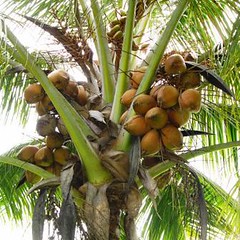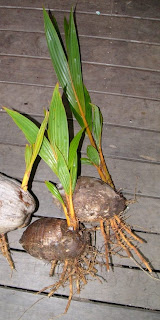Here is the background to the spicata dwarfs in the Townsville Palmetum. By Mike Foal - www.cocosplit.com
In my role as an agronomist located in the Russell Island group of Solomon Islands to work in the Joint Coconut Research Scheme (JCRS) funded equally by the Solomons colonial government and Unilever I visited the Polynesian island of Rennell (200 km south of Guadalcanal) by small government vessel in September 1964. While purchasing seed-nuts of the indigenous Rennell Tall population (for a variety trial and despatch to other research centres around the world) from village groves scattered on Rennell, I noticed a "village dwarf" (delicate dwarf palm with orange fruit) that had the "Spicata" character. Each inflorescence of such palms comprises a single branchless stalk in contrast of the normal inflorescence that might have 12 or more branches connected to the main stem. The Spicata inflorescence has many female flowers extending from the base almost to the end of the stalk and a small number of male flowers at the end.
At that time we had begun generating hybrids at the JCRS and were interested in the fact that a Spicata inflorescence produces very little pollen. We could see that an inflorescence with 12 branches would bear at least 12 times more pollen that a Spicata inflorescence. A low pollen producer would be far more likely to outcross and so a high proportion of seeds from a Spicata palm surrounded by non-Spicata would be natural hybrids, whereas non-Spicata dwarf palms, being mostly self-pollinating, would require expensive male flower removal to force hybridisation.
So we collected some seed-nuts from this palm and planted a group of them on the research station. Since that time we realised that the Spicata gene, a mutant that appears rarely but is known in some other countries, is actually a dominant gene, so that any progeny will display the trait even when hybridised with a non-Spicata palm.
Seed-nuts of Spicata orange dwarf were imported from the JCRS (Solomons) palms by the Townsville City Council in 1998 and established in the Palmetum. Several of the palms from these seeds are true Spicata dwarf and some are evidently hybrids as the dwarf character is modified and the orange colour (a recessive gene) is not expressed.
It seems to me that the attractive fruit colour, the delicate dwarf from, and the unusual inflorescence stalk make the Spicata dwarf an ideal ornamental palm.
Mike Foale has written a comprehensive book on coconuts “The Coconut Odyssey: the bounteous possibilities of the tree of life”. Purchase it, or download it for free here: http://www.aciar.gov.au/publication/MN101






